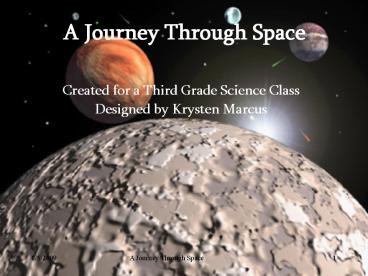Created for a Third Grade Science Class - PowerPoint PPT Presentation
1 / 16
Title:
Created for a Third Grade Science Class
Description:
... Neptune, Earth, Venus, Mars, Mercury, and Pluto. ... Pluto was discovered in 1930 by Clyde Tombaugh. Pluto is the only planet that has not been visited ... – PowerPoint PPT presentation
Number of Views:293
Avg rating:3.0/5.0
Title: Created for a Third Grade Science Class
1
A Journey Through Space
- Created for a Third Grade Science Class
- Designed by Krysten Marcus
2
Lets Name the Planets!
Mercury
Saturn
Venus
Uranus
Earth
Neptune
Mars
Pluto
Jupiter
3
An Easy Way to Remember
- M ? My
- V ? Very
- E ? Excited
- M ? Mother
- J ? Just
- S ? Served
- U ? Us
- N ? Nine
- P ? Pizzas
You can remember the planets by using mnemonics
where the first letter of each word represents
the planet. The mnemonic sentence would say My
Very Excited Mother Just Served Us Nine Pizzas.
READY FOR THE QUIZ ?
4
What is in the Solar System?
- There are nine planets in our solar system and
the sun is the center of the solar system. - The size of the planets rank from largest to
smallest Jupiter, Saturn, Uranus, Neptune,
Earth, Venus, Mars, Mercury, and Pluto.
If you click on the star it will take you to the
Enchanted Learning Website where you can view
many graphs and charts that represent mass,
temperature, gravity, and density.
5
MERCURY
- Mercury is sever billion years old.
- Mercury is the closest to the sun.
- The temperature on Mercury is very hot in the day
time and very cold at night. - The core of Mercury is 75 iron.
- Ice is predicted to lay on the bottom of the
planet.
6
VENUS
- Venus is about the size of Earth.
- The weather on Venus is always the same everyday.
It is very hot, dry, an d windy. - It is covered with lava and volcanoes.
- Venus rotates backwards and has an atmosphere
composed of carbon dioxide. - The core of Venus is made of iron and nickel.
7
EARTH
- Our home sweet home
- Earth is a rocky planet.
- The earth turns once every day!
- Earth is also the only planet that has liquid
oceans. - The earths core is made up many elements such as
nickel, silicon, iron, magnesium, and oxygen.
8
MARS
- Mars is half the size of the earth.
- Mars is known as the red planet. It is red
because of the crust containing iron oxide. - Mars is covered with dust. If you were to walk
on Mars you would sneeze! - It takes Mars 687 days to rotate around the sun!
- Mars has 2 tiny moons.
9
JUPITER
- Jupiter is bigger than all of the planets in the
solar system combined. - Jupiter is 90 hydrogen and 10 helium.
- Jupiter has no solid surface and has 4 very hard
to see rings made up of dust particles. - Jupiter has 4 natural satellites.
- The Great Red Spot is located in the upper
atmosphere of Saturn where violent storms take
place.
10
SATURN
- Saturn is the second largest planet in the solar
system. - Saturn is a yellowish color and it made up of
hydrogen and helium. - The rings of Saturn form a band about 125,000
miles long. - Saturn also has 30 moons that we know of.
11
URANUS
- Uranus was found in 1781 by William Herschel by
using a telescope. - Uranus is made of rock, ice, and hydrogen.
- Uranus is the third largest planet in the solar
system. - It rotates laying on its side with 11 rings
surrounding. - It takes Uranus 84 years to rotate around the
sun! - Uranus has 21 satellites and 16 moons
12
NEPTUNE
- Neptune is a blue planet that is like Uranus and
was discovered in 1846 by Galle from math
calculations. - Neptune is a gaseous planet with 4 outer rings
that are thin and dark and made of dust. - The mantle of Neptune is made of ice, the core is
rocky, and the atmosphere is composed of
hydrogen, helium and methane. - The Voyager photographer a big hurricane on
Neptune called the Great Dark Spot. - Neptune has 8 natural satellites.
13
PLUTO
- Pluto was discovered in 1930 by Clyde Tombaugh.
- Pluto is the only planet that has not been
visited to by a space probe. - It is the same size as the Earths moon.
- Scientist believe that the surface of Pluto is
covered with methane, nitrogen, and carbon
dioxide. - Pluto is probably 80 rock and 20 ice.
14
Lets Recall the Nine Planets
Can you remember all nine Planets? A chart is
listed below please fill in the rest of each word
creating all nine planets.
If you still need more practice click on the red
arrow. If you are ready to check your answers
click the green arrow.
15
ANSWERS
YOU DID IT! You know all of the nine planets. I
hope you enjoyed your Journey into Space. You
are now an official planet expert!
16
Sources
- Books Used
- Rabe, T. Theres no place like space All about
our solar system. (1999) Dr. Seuss Enterprises.
New York, NY. - World Almanac Library. The solar system and the
stars. (2001) World Almanac Library. Milwaukee,
WI. - Images used from
- www.google.com
- Microsoft Clip Art, Word Art, and Autoshapes
- Websites used
- http//www.enchantedlearning.com/subjects/astronom
y/planets/ - http//www.nineplanets.org/
- http//www.kidsastronomy.com/solar_system.htm
- http//www.spacekids.com/solarsystem/
- http//www.nasa.gov































